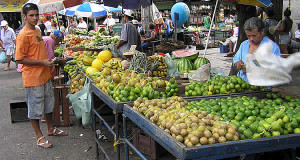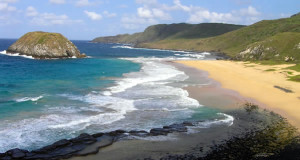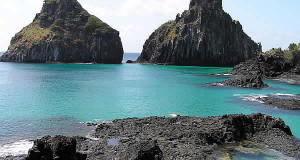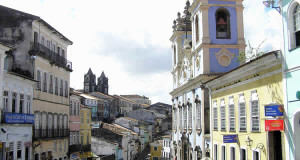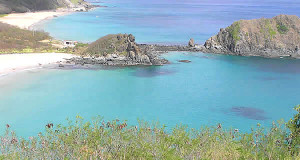Peru (República del Perú/Republic of Peru) is a presidential republic located in central western South America. The country is washed by the Pacific Ocean to the west and bordered to the north by Colombia and Ecuador, to the east by ...
Read More »The climate of Ecuador: when to go to Ecuador
Despite being a small country, the climate of Ecuador is very different depending on the various areas of the country. This is mainly caused by the large altitude difference between the various climatic zones of the country. The coast of ...
Read More »Ecuador: Andes, volcanoes and nature
Ecuador (República del Ecuador/Republic of Ecuador) is a presidential republic located on both sides of the equator in the north-west of South America. It is washed by the Pacific to the west, borders to the north with Colombia and to ...
Read More »The climate of Colombia: when to go to Colombia
The climate of Colombia, because of proximity to the equator presents temperatures suffering only slight variations during the year, but they vary greatly depending on the height. THE CLIMATE OF THE CARIBBEAN COAST OF COLOMBIA Along the Caribbean coast in ...
Read More »Colombia: a country with multiple and diverse landscapes
Colombia (República de Colombia/Republic of Colombia) is a presidential republic, located along the equator on the north-west side of South America. It is washed to the west by the Pacific Ocean and to the north by the Caribbean Sea and ...
Read More »The climate of Chile: when to go to Chile
The extension of Chile for over 4,600 km from north to south means that the country is affected by different types of climate. To the north we find the desert and semi-arid climate that characterizes the Atacama desert and the ...
Read More »Chile country of contrasts: deserts, mountains and glaciers
Chile (República de Chile/Republic of Chile) is a presidential republic situated in the south-west of South America. It is washed by the Pacific Ocean to the west, to the north it borders with Peru, to the north-east with Bolivia and ...
Read More »The climate of Brasilia: when to go to Brasilia
Brasilia has a tropical climate of altitude typical of tropical savannas, being more than 1,100 meters above sea level the temperatures are mild and never too hot or too cold, the average annual temperature is 21.2 ° C. The seasons ...
Read More »Brasilia: a masterpiece of futuristic architecture
Brasilia, the capital of Brazil, rises around an artificial lake, Paranoá lake, at over 1,150 meters above sea level in the Goiás plateau (Planalto Central). Administratively the territory of Brasilia is called Distrito Federal. This territory is almost completely surrounded ...
Read More »The climate of São Paulo: when to go to São Paulo
The city of São Paulo has a sub-tropical climate, with seasons quite variable, generally speaking, the winters are mild and relatively dry and the summers are hot and very rainy. Being close to the sea, the winds coming from the ...
Read More »São Paulo: the megalopolis of Brazil
São Paulo is the largest city in Brazil, as well as the largest commercial, industrial and financial center in the country. This is a real megacity that has a population of over 11 million inhabitants, which become about 22 million ...
Read More »The climate of Rio de Janeiro: when to go to Rio de Janeiro
The climate of the city of Rio de Janeiro is tropical marine, hot and humid. Based on the rainfall we have two seasons, a rainy season between December and April, and a relatively dry season, between May and November. Temperatures vary ...
Read More »Rio de Janeiro: one of the most beautiful bays in the world
The city of Rio de Janeiro is located in one of the most beautiful bays in the world, the Guanabara Bay. This bay presents an unparalleled natural scenery, dotted with inlets, famous beaches such as Copacabana and Ipanema, and bizarre ...
Read More »The climate of Recife: when to go to Recife
The city of Recife has a tropical maritime climate with slight variations in seasonal temperatures, but characterized by rainfalls. Based on the rainfall there may, in fact, distinguish two seasons, the first one is wet and rainy which roughly corresponds ...
Read More »Recife: also called the Venice of Brazil
Recife, is a historic city in the Northeast of Brazil as well as being the capital of the state of Pernambuco. This city which is one of the economic engines of Brazil has a population of over one and a ...
Read More »The beaches of Fernando de Noronha
The main tourist attractions of the island of Fernando de Noronha are undoubtedly its numerous beaches and the transparency and color of the sea. In addition to this, the high cliffs that characterize much of the coast of the island ...
Read More »The climate of Fernando de Noronha: when to go
The climate of Fernando de Noronha is tropical, with two well-defined seasons, a rainy season from February to July and a dry season from August to January. The island is in fact just south of the equator so temperatures vary ...
Read More »Fernando de Noronha: paradise of nature and wildlife
Fernando de Noronha (3 ° 51’S, 32 ° 25’O) is a volcanic island in the Atlantic Ocean which, with some smaller islets, forms an archipelago covering a total area of 18.4 sq km. The archipelago is made up of the ...
Read More »The climate of Fortaleza: when to go to Fortaleza
The city of Fortaleza has a humid tropical climate, with rain and high humidity, but with a well-defined dry season, with high and stable temperatures throughout the year, mitigated by the breath of the winds that come from the sea. In Fortaleza ...
Read More »Fortaleza: beaches, nightlife and forró
The capital of the state of Ceará, Fortaleza, is a modern city and an important industrial center and market for agricultural products. The city is also a famous tourist destination thanks to its long beaches that have made it a ...
Read More »The climate of Salvador: when to go to Salvador de Bahia
The climate of the city of Salvador (Bahia) is tropical climate characterized by high temperatures, high humidity, and rainfall in each month of the year, without a marked dry season, but with high levels of precipitation in the winter and ...
Read More »Salvador: colonial city and former capital of Brazil
Salvador (Bahia) is one of the historical cities of Brazil. This city was founded in 1549 by the Portuguese and immediately became the capital of the colony of Brazil. For over two hundred years it remained the capital of the ...
Read More »The climate of Brazil: when to go to Brazil
Brazil in terms of climate falls entirely within the tropical climate. Despite this, the country has some important differences between the various regions. This happens because of its extension from north to south, which varies between 5 degrees north and ...
Read More »Brazil: the economic engine of Latin America
BRAZIL IN THE WORLD: ITS POSITION Brazil (República Federativa do Brasil/Federative Republic of Brazil) is a federal presidential republic. Situated roughly between the equator and the Tropic of Capricorn the country is washed to the east by the Atlantic Ocean ...
Read More »The climate of Bolivia: when to go to Bolivia
Bolivia climate varies dramatically between different regions of the country, although the whole Bolivian falls entirely in the tropical area, climate is affected greatly by differences in height and in precipitation. For example, the average annual temperature in La Paz, ...
Read More »Bolivia: landscapes and multicolored populations
Bolivia (Estado Plurinacional de Bolivia/Plurinational State of Bolivia) is a presidential republic located in central-western South America. It is a landlocked country and bordered to the north and to the east by Brazil, to the south by Paraguay and Argentina ...
Read More »San Ignacio Mini: ruins of a Jesuit Guarani mission
Located in the north of Argentina. In the part of Argentine territory that is wedged between Paraguay and Brazil up to the Iguazu Falls. San Ignacio Miní was one of the many missions founded by the Jesuits in South America ...
Read More »The climate of the Iguazu Falls: when to go to Iguazu Falls
The Iguazu Falls are located in an area of tropical rainforest, characterized by frequent rains and high humidity of the air, the region’s climate is sub-tropical humid, and is divided into two distinct seasons, the hot and wet summer season from October ...
Read More »Iguazu Falls: the natural wonder of South America
The Iguazú Falls are located along the border between Brazil and Argentina. These waterfalls are formed by the river of the same name, which creates one of the natural wonders of planet Earth. The Brazilian part of the falls is ...
Read More »Iguazu Falls: what to see on the Argentine side
The Argentine side of the Iguazu Falls is located in the northeast of the Argentine province of Misiones, along the border with Brazil, 17 kilometers from Puerto Iguazú. To preserve the sub-tropical forest around the falls and the falls themselves, ...
Read More » Travel Guide Travel Guide to the countries of the world
Travel Guide Travel Guide to the countries of the world





